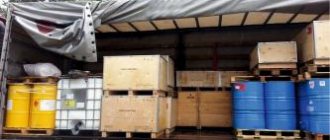Every sane person understands perfectly well that transporting dangerous goods is a very risky undertaking, and poses a potential threat to both people and the environment. For this reason, special rules for the transportation of dangerous goods have been created, which are regulated at the legislative level. The main document reflecting all the nuances of this event is ADR (European Agreement on the Transport of Dangerous Goods). In addition, for some especially dangerous goods, additional regulations have been created, the failure of which may result in a fine for transporting dangerous goods without a permit, as well as using other types of vehicles.
Classification
The list of dangerous goods compiled by the UN includes 3.5 thousand items.
Among them are the following classes:
- Explosives that can detonate during movement.
- Gaseous substances in various storage containers.
- Flammable liquid and solid elements.
- Oxidizing substances.
- Infected materials and poisons.
- Objects contaminated with radiation, waste from radioactive production and materials themselves that are highly radioactive.
- Alkalis, acids and other corrosive elements.
Transport mode
Each dangerous cargo has its own instructions for transportation. The basic transportation rules are as follows:
- Availability of necessary equipment (sealed tanks, cylinders, containers, etc.).
- Strengthened and reliable brakes, additional locking brake system.
- Reliable isolation of dangerous cargo from other components and assemblies of the machine.
- Availability of general and special fire extinguishers.
- More than 3 years of experience and driver's permits.
- External design of the vehicle with dangerous cargo signs.
- Statutory documentation from the shipper.
Sanctions for non-compliance
The Russian legal framework has developed strict measures for improper transportation of dangerous goods. They are indicated in Art. 12.21.2 of the Code of Administrative Offenses of the Russian Federation:
- If a license and other necessary permits are not issued, and the equipment of the vehicle does not correspond to the type of cargo, the law punishes all participants. The driver will be charged 2-2.5 thousand rubles. and may be deprived of rights for up to 6 months.
- Managers will be charged 15-20 thousand rubles.
- Legal entities that are the owners of a transport company will be punished the most. Their penalties will amount to up to 0.5 million rubles.
Liability for violation of ADR by motor vehicles
Taking into account the severity of the violation, it is envisaged to apply administrative and criminal liability measures against violators.
For incorrect transportation
Improper transportation of exhaust gases means transportation without fulfilling the requirements provided for by law. This violation provides for the imposition of fines (hereinafter – in rubles):
- driver – from 1,000 to 1,500;
- responsible employees of companies – from 5,000 to 10,000;
- organizations – from 150,000 to 250,000.
These penalties are established by Part 2 of Art. 12.21.2 Code of Administrative Offenses of the Russian Federation.
For lack of documents for ADR
If dangerous cargo is transported in the absence of an ADR certificate from the driver, papers on the admission of transport to this operation, a permit issued by the transport supervision, or an issued emergency card for the transported materials, the punishment provided for in Part 1 of Art. 12.21.2 Code of Administrative Offenses of the Russian Federation, with the imposition of fines:
- for the driver – from 2,000 to 2,500;
- for officials – from 15,000 to 20,000;
- for legal entities – from 400,000 to half a million.
The driver has ADR.
A fine for the driver not having ADR and other necessary documentation can be replaced by deprivation of a driver’s license for a period of 4 to six months.
The same article of the Code of Administrative Offenses of the Russian Federation applies to the transportation of exhaust gases by transport that is not properly equipped, in the absence of satellite monitoring systems.
Criminal liability is provided for a legal entity if the ADR certificate or other documents are fake (fake).
Attention! According to Part 5 of Art. 327 of the Criminal Code of the Russian Federation, the use of knowingly forged papers threatens with a fine of up to 80,000 rubles, compulsory labor for up to 480 hours, correctional labor for up to two years, arrest for up to six months.
For driving a vehicle while intoxicated
If the violation did not lead to consequences using criminal law, in accordance with Part 1 of Art. 12.8 of the Code of Administrative Offenses of the Russian Federation, the punishment provides for a fine of 30,000 rubles for the driver. with revocation of rights for one and a half to two years.
If the driver did not have access to driving a car, in accordance with Part 3 of this article of the Code of Administrative Offenses of the Russian Federation, a similar fine or arrest of the offender for 10–15 days may be imposed.
In case of causing serious harm to health while driving a car while drunk, Part 2 of Art. 264 of the Criminal Code of the Russian Federation with the appointment of forced labor for up to 5 years, imprisonment for 3–7 years. If the victim dies, the punishment becomes even more severe.
For illegal transportation of weapons and materials for their creation
Penalties for illegal transportation of weapons and materials from which such weapons can be created are determined by Part 1 of Art. 222 of the Criminal Code of the Russian Federation. Restriction of freedom for up to 3 years, forced labor for up to 4 years, arrest for up to six months or imprisonment for up to 4 years are provided. At the same time, they may impose a fine of 80,000 rubles.
For environmental damage
Punishments for causing environmental damage are determined by the following articles of the Criminal Code of the Russian Federation:
- 250 – for polluting water bodies with a fine of up to 80,000 rubles, compulsory labor for up to 360 hours, correctional labor for up to 12 months, arrest for up to 3 months;
- 252 – for danger to the marine environment with a fine of up to 200,000 rubles, compulsory labor for up to 480 hours, correctional labor for up to 2 years, arrest for up to 4 months.
- 254 – for damage to land resources with the establishment of punishment similar to Art. 252 of the Criminal Code of the Russian Federation (excluding arrest).
Measures are tightened if pollution causes death or serious damage to the environment.
For creating an emergency situation
Directly creating an emergency situation is not qualified by Russian legislation. They suggest punishment taking into account the nature of the wrong actions that led to an accident or the risk of a traffic accident.
According to Art. 12.14 Code of Administrative Offenses, dangerous maneuvering threatens the driver with a fine of 500 rubles.
Wrong oncoming traffic, overtaking takes into account art. 12.15 of the Code of Administrative Offenses of the Russian Federation with the following options for fines for various violations:
- driving to the side of the road, if prohibited – 1,500 rubles;
- moving along the sidewalk or bicycle path - from 1,000 to 1,500 rubles;
- driving into the oncoming lane in violation of traffic rules – 5,000 rubles. (or withdrawal of rights for 4–6 months).
If harm is caused to the health of other people, the punishment is established by Art. 12.24 Code of Administrative Offenses of the Russian Federation. The amount of the fine depends on what harm was caused:
- light - from 2,500 to 5,000 rubles. or deprivation of access to driving from one to one and a half years;
- average – from 10,000 to 25,000 rubles. or withdrawal of rights for one and a half to two years.
In case of serious harm to the health of the victim, in accordance with Part 1 of Art. 264 of the Criminal Code of the Russian Federation, the driver faces restriction of freedom for up to three years, forced labor for up to two years, arrest for up to six months, imprisonment for up to two years.
ADR/ADR standards
Since 2021, the European Agreement concerning the International Carriage of Dangerous Goods by Road (ADR) has become the legislative basis for the transportation of dangerous goods. Russia has been fulfilling its requirements since 1994 on international routes.
Since 2021, international ADR standards have been in force in our country.
This international document assigns a special UN number (UN identifier) to each type of hazardous elements in a special List. The following rules have been developed for them:
- marking on the body and parts of the machine, container or packaging;
- danger warnings on vehicles and containers;
- indication of the class of the substance;
- loading and unloading algorithm;
- indication of the degree of danger;
- designation of the transport unit, etc.
ADR defines 13 main hazardous substances:
- gasoline, diesel, kerosene fuel;
- explosive substances - gunpowder, firecrackers, cartridges, etc.;
- gas;
- poisons;
- explosive and flammable elements;
- capable of causing oxidation and corrosive destruction;
- radioactive elements;
- hazardous waste, etc.
They can be transported by a driver who has at least three years of continuous driving experience and who has undergone special ADR training. The vehicle must have the appropriate permit.
For the vehicle you need to obtain a certificate from the traffic police for the transportation of explosive goods and liquids. Freight transport must have a diagnostic card indicating that it has undergone technical inspection every 6 months. Before submitting an application for licensing, you must obtain a permit to work with hazardous substances from the police department, and agree on a route list with the traffic police.
List of documents
Documents required for persons transporting dangerous goods:
- driver’s certificate, which must indicate the degree of preparation of the carrier to carry out these actions;
- approval of the vehicle used for transportation;
- a route sheet, approved and agreed upon in accordance with the accepted rules (more information about the features of the route sheet and what fines are provided for its absence can be found here);
- emergency card, which provides information about the degree of danger of the cargo and how it should be handled correctly;
- invoice for goods;
- ADR permit
The last paragraph is a document that is a special permit:
Without it, transportation will not be possible. A special permit, certified in accordance with the procedure established by law, allows the driver to drive this vehicle transporting material classified as hazardous. The transportation company confirms with this document the right to conduct this activity. If a logistician does not have ADR and does not have a license to work with this type of cargo, the organization will be fined.
Having an ADR permit confirms that the driver knows exactly how to observe safety precautions for this case and knows how to apply these rules.
The document also indicates that the vehicle’s equipment is specialized and fully prepared for the transportation of this cargo. When transporting dangerous goods, drivers are required to present licenses to controllers ; they should be completed before the trip.
To receive a document, you must complete the steps in this order:
- obtain permission to operate from the Department of Internal Affairs;
- agree on the route list with the traffic police.
Employees involved in the transportation process must receive timely instructions on work rules and regularly update their knowledge. In this case, there is no danger for the transport company to suffer serious financial losses due to the incompetence of its personnel.
Violators of ADR are seriously punished
Transporting dangerous goods without ADR is subject to penalties provided for in the Administrative Code. In addition, maximum penalties are imposed for the following types of non-compliance:
- The driver has not been trained and has not received a certificate of completion of courses on working with dangerous loads.
- The managers did not obtain the required vehicle approval.
- No special permit or cargo hazard information system emergency card has been received.
- The vehicle is not suitable for transporting this type of dangerous cargo.
- The vehicle and container are not marked with the required marking symbols and other necessary information about the dangerous cargo.
- The conditions for transporting hazardous elements are not met.
For less serious violations the following penalties are imposed:
- For drivers – a fine of 1-1.5 thousand rubles.
- For managers – up to 1 thousand rubles.
- For owners and companies – 150-250 thousand rubles.
Is it possible to carry gasoline in cans in a car?
Yes. And this is precisely the exception. Although, it is for flammable substances that special requirements are imposed.
Clause 1.1.3.1 of the said ADR prescribes the possibility of transporting gasoline (both leaded and unleaded) in the trunk or passenger compartment of a car, subject to the following conditions.
- the total amount of gasoline transported must not exceed 240 liters per vehicle,
- at the same time, it must be packaged in containers of no more than 60 liters each (canisters, bottles, etc.).
Here is the official interpretation of this point:
When such goods are flammable liquids carried in reusable receptacles filled by or for a private person, the total quantity shall not exceed 60 liters per receptacle and 240 liters per transport unit. Dangerous goods placed in IBCs, large containers or tanks are not considered packaged for retail sale...
The previously cited text contains the basic requirements for this:
The carriage of dangerous goods by private persons when these goods are packaged for retail sale and intended for their personal consumption, domestic use, leisure or sport, provided that measures are taken to prevent any leakage of the contents under normal conditions of transport.
Please note that these are exhaustive requirements for the carriage of this dangerous cargo. At the same time, the following conditions for transportation are not prohibited by any other law, and, therefore, are permitted.
- Paragraph 1.1.3.1 refers to gasoline packaged in reusable containers. This means that if gasoline is disposable, then essentially these rules do not apply to it. However, we would not recommend violating them in any case in order to avoid problems with traffic police officers.
- There is no question that gasoline must be in cans - it can be transported in bottles, other plastic containers, and barrels up to 60 liters. The main thing is that the permissible weight of the passenger car is not exceeded, as required by clause 23.1 of the traffic rules.
- By the way, in the official interpretation there is not a word that it must be a passenger car - transportation for personal needs by truck is not excluded.
- You have the right to carry dangerous goods not only in the trunk, but also in the cabin of the car.
- Transportation is also permitted under the same conditions, including for the retail sale of gasoline.
- You just have to ensure that fuel leaks are prevented. The same requirements are contained in paragraphs 23.2-23.3 of the traffic rules for any cargo.
- To transport gasoline in the specified quantities and containers, documents for it are also not required (special permit, certificate, emergency card, etc.) - not a single law provides for this. And the car structure also does not need to be equipped for this.
Transportation of diesel fuel
Paragraph 1.1.3.1 speaks not only about gasoline and even not only about fuel, but also about any other flammable substance in liquid form. Accordingly, diesel fuel is subject to the same dangerous goods regulations and requirements.
In particular, if you are transporting diesel fuel in a truck in barrels, then you need to ensure that there is no more than 240 liters of fuel per vehicle, and it is prohibited to package it in 200-liter barrels.
However, for violation of this requirement, a fine is provided under Part 2 of Article 12.21.2 of the Code of Administrative Offenses of the Russian Federation, and not under Part 1 as for commercial transportation. Although, in practice, in 2021, a traffic police officer can issue documents under Part 1 - especially if the truck belongs to a legal entity or entrepreneur.
When ADR is not needed
Some transport can be carried out without ADR. The requirements of this international agreement are not mandatory in the following cases:
- For vehicles whose speed limit does not exceed 40 km/h.
- For transport of the Russian Army.
- For private owners transporting goods for personal consumption.
- For goods transported by special authorities and rescue services during emergency rescue operations.
- For transportation of waste from existing enterprises.
- For transportation of empty containers.
- Cargoes not listed in the ADR list.
- With small container sizes, low weight, which are determined in each specific case, etc.
Permits for transportation of high-risk cargo
The list of this type of cargo is contained in table 1.10.3.1.2 ADR. To transport them, you must obtain a permit.
Depending on the route, permits are issued by Rostransandzor (for travel on federal highways), local executive authorities (for transport on regional and municipal roads), and the owner of the road (for travel on private areas). The maximum validity period of the permit is 1 year.
To obtain permission, you must provide copies of the following documents:
- vehicle registration certificate;
- confirmation of ownership or rental agreement;
- permitting a vehicle to transport dangerous goods;
- Driver training certificates.
The following requirements apply to all vehicles:
- Equipment with satellite navigation systems GLONASS, GLONASS/GPS.
- Installation of orange plates made of fireproof and durable materials with the cargo identification number and hazard code printed on them.
- Applying the number, hazard code, load position arrows and other marking elements on the container or packaging.
There are increased requirements for waybills. The accompanying documentation must include the following information:
- Information about the cargo according to ADR classification.
- Description of packaging and number of packaging units.
- Indication of especially dangerous goods.
- Additional information about temperature and other conditions of cargo transportation, explanation of symbols.
- Instructions for driver safety and behavior in emergency situations.
- Permit for transportation of especially dangerous goods.
- Substance passport, product safety data sheet, certificates.
- Invoice.
- Technical passport, technical certificate and driver's license.
Dangerous goods
Hazardous substances are substances whose leakage during transportation and storage is associated with danger to humans or the environment. The classification of such materials is established (based on the nature of the impact) by the European agreement - ADR.
The listed materials are divided into classes (with subclasses) indicated in the table.
| Class or subclass | What substances are included? |
| 1 | Explosive |
| 2 | Gases in a liquefied or compressed state with transportation in oxygen and other gas cylinders, special containers (gas carriers and other transport) |
| 3 | Liquids with a flammability hazard (fuel trucks, tank trucks) |
| 4.1 | Flammable solid components, self-reactive and solid desensitizing explosive materials |
| 4.2 | Prone to spontaneous combustion |
| 4.3 | Emitting flammable gases when interacting with water |
| 5.1 | With oxidizing properties |
| 5.2 | Peroxides of organic origin |
| 6.1 | Toxic components |
| 6.2 | Infectious hazard |
| 7 | With radioactive radiation |
| 8 | Corrosive materials |
| 9 | Other components not classified in any of the listed classes |
Hazardous substances are classified as a special category of cargo, which is prohibited from being transported by conventional trucks or other means of transport without taking precautions:
- container markings;
- the use of properly equipped vehicles;
- training of involved personnel;
- elaboration of regulations for the movement of materials with certain legislation and coordination of procedures;
Dangerous goods
Each substance is assigned a four-digit UN number indicating the nature of the component and how it should be handled.
High-risk cargo may be transported by organizations that have received the appropriate permit (for road transport) or a license (for other cargo transportation) from state regulatory authorities.
Each such operation is separately coordinated with supervisory agencies, highway owners, and other interested parties. Prepare the documentation required by law.
Penalties for transportation violations
For transportation of especially dangerous goods without permission, the maximum fines provided for in the relevant article of the Administrative Code of the Russian Federation are imposed. Drivers, managers and company owners are subject to penalties.
Traffic police officers will stop the car and prohibit its further movement along the route if they detect the incorrect transportation of particularly dangerous cargo. The courts may order an additional large sum to be paid to the state, and criminal penalties may be imposed on the drivers.
Controversial traffic violations
To avoid punishment, you must comply with the conditions prescribed by law. The driver is required to carry the necessary documentation, maintain speed and not deviate from the agreed route.
You cannot use fake IDs, certificates and other documents so that the actions are not qualified under Art. 327 of the Criminal Code of the Russian Federation.
It is also important to take into account that violations of the rules for the transportation of dangerous goods, in accordance with Part 1 of Art. 27.13 of the Code of Administrative Offenses of the Russian Federation, create a situation where further movement of the car poses a danger. As a result, transport may be delayed until the circumstances are clarified and the violations are eliminated.
If an accident occurs...
Accidents and incidents involving vehicles with cargo that poses a threat to others can be serious and destructive. They often kill or seriously injure people, the driver and other road users. The accidents that occur cause damage to the environment and the surrounding area.
In such cases, the court may imprison the culprit for 2-9 years if people die or are seriously injured in the accident.
If a person is drunk and driving a car with dangerous cargo, they will be charged up to 200 thousand rubles. or imprisonment for 2 years.
The managers and owners of transport companies that organize the route are also punished for accidents and emergencies that occur on the road. In addition to fines, the court may award legal entities compensation for death and injury to people and damage to the environment.
Exceptional cases when transportation is possible without permission and without signs
On March 12 of this year, the law on “special cargo” intended to ensure state security came into force. Such cargo can be transported without permission.
The list of such cargo is established by a special government act.
A permit will not be required for self-propelled vehicles transporting particularly dangerous goods.
Without plates with detailed markings, dangerous goods can be transported on one transport unit if the tonnage and quantity are less than the standards specified in ADR.
Is the transport of dangerous goods allowed in 2021?
Yes. However, it is necessary to separate commercial and/or bulk transportation in large containers, tanks and other large containers from ordinary movement in a passenger car, in the trunk of which there is something that poses a danger.
So, the first place that almost any driver looks when a question arises about driving on the roads, including to find out whether it is possible to transport dangerous goods by car, is the traffic rules. And there really is an answer here, although it will not satisfy us. Let's look at the chain of legislation that will lead us to the answer.
- Clause 23.5 of the Traffic Regulations indicates that the transportation of dangerous goods must be carried out in accordance with the Law on Highways and Road Activities.
- Ok, let's go to this legal act and see in paragraph 1.1 of Article 31 that the movement of hazardous substances in Russia must be carried out in accordance with a special European agreement, also called ADR. Moreover, to be able to do this, you must obtain permission.
- Below on this point we can see that the only exceptions are military equipment, self-propelled vehicles with weapons and other vehicles related to the armed forces.
- All that remains is to rely on ADR. Although, by looking at this legal act, we can find out that there are as many as 739 pages regulating the rules for the transportation of dangerous goods.
But in 2021, there is still an opportunity to transport gasoline, diesel fuel, alcohol and other hazardous substances without a fine. However, this requires consideration of each individual such cargo and its corresponding requirements. In the meantime, let’s find out the size of the sanctions for such violations.
By the way, on most Internet sites you can see information about the regulation of our issue with various kinds of Decrees of the Government of the Russian Federation or Orders. However, this information is outdated as of 2021 and therefore not true.
Today, instead of all regulations on dangerous goods, only one has been introduced - PPRF No. 2200, which does not in any way regulate the possibility of transportation for personal needs and by individuals.
Pros and cons of obtaining the status of an individual entrepreneur
The legal system does not restrict the work of individual entrepreneurs in this area.
Individual entrepreneur status provides the same opportunities as for a legal entity, but more preferential taxation. However, the individual entrepreneur may encounter the following difficulties:
- The main customers, legal entities, prefer to work with contractors who pay VAT, i.e. are on the OSNO (general taxation system).
- Legal entities can be interested in cooperation by reducing transportation tariffs by 18% from the cost offered by other competing companies that work for OSNO.
Compliance with legislation is mandatory for all transport systems
In addition to road transport, other types of vehicles may be involved in the movement of dangerous goods. The main rules of ADR with such a combined route must be observed on all transport systems:
- railway;
- water or sea;
- air
The organizer of road transportation must provide his vehicle in advance with the necessary equipment for loading and unloading operations onto other types of transport for a combined route.
In the area of close attention of the traffic police and regulatory authorities
Every dangerous goods transport organizer has a lot of work to do before sending a vehicle on the road. But you need to fulfill every point, because violations are punished strictly, and the attention of the traffic police throughout the trip will be increased.
Vehicles carrying dangerous goods are only allowed to travel on those roads that have been designated by regulatory authorities as acceptable for the movement of this type of vehicle.
Along sections of the routes, video cameras are installed to monitor the road situation. The driver will not be able to avoid responsibility for violating traffic rules.
At each traffic police post, employees pay increased attention to transport with dangerous goods.
The transport company must comply with the rules of documentation, monitor the condition of the vehicle fleet, and hire experienced drivers who have undergone the necessary training. By complying with the legal requirements for the rules for the transportation of dangerous goods, the organizer will be able to ensure safe work in this complex area.
List of documents for the transportation of dangerous goods.
Views: 8,949
Traffic police checks
Traffic police officers pay increased attention to the transportation of dangerous goods. Such transport is checked during its journey and the accompanying documentation is examined. The absence of the necessary papers threatens to hold drivers, company employees and legal entities themselves liable in accordance with the legal norms reflected earlier.
If the transport operation is carried out in conditions of poor visibility or difficult terrain, it is possible to organize escort by traffic police vehicles.
traffic police










